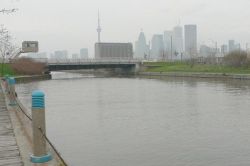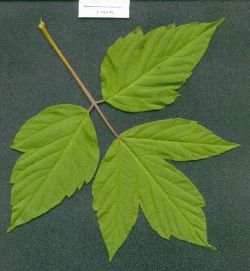Toronto Media Co-op
Local Independent News
Of Settlers and Foreign Maples
Knowing the Land is Resistance is a project based in the remaining carolinian forest nestled between the limestone cliffs of the niagara escarpment and the water of lake ontario. Each month, we explore a different wild space in this area, discuss some of its interesting features, and consider how developing a more intimiate connection with that land can advise our activism and participation in social movements. This is the first part of a two-part series we recently did about the Don River. For the second part, and for other interesting treats, check out our website: knowingtheland.wordpress.com
We enter the Don River Valley at the end of three days of storms, and the river runs high and full. In most river systems, this new surge of water would be a re-energizing gift, full of nutrients swept in from the land. But the Don River’s watershed is 90% developed, making it the most urbanized river in Canada, and water that passes through an enormous city like Toronto is a whole different story.
Our intention is to hike the river from its beginnings in the north end of Toronto towards the downtown. But to get to our starting point at Garnier Park, just south of Steeles Ave, we needed to drive along the Don Valley Parkway. This massive highway follows the river for most of its length, its overwhelming presence defining the Don and making a healthy valley almost impossible to imagine. Stuck in traffic, we consider the rainfall of the past few days. Water leeches too quickly through the bare ditchs of roads like this one, as sewers overflow and city streets dump their grime directly into the river. South of Gerard St, the river was straightened to control its natural rhythm of flooding, and so our first glimpse of the Don today is of its burdened waters flowing in a concrete canal.
The history of this region is tragic. This area of the city, where the Don flows into the Great Lakes, was once Ashbridges marsh. At the turn of the century, the already heavily polluted marsh was filled-in under the ‘Don Improvement Project’. This was done in the name of public health concerns surrounding the pollution from 31 sewage facilities and 21 landfills adjacent to the river. Even today, you will still hear the Don referred to as an open sewer. Yet what drew us here are the tales from local residents of the hopeful transformations they have seen during their lifetimes, like the recent return of spawning salmon and the presence of beavers and snapping turtles.
We reach the beginning of our walk out in the suburbs, seeking the narrow wild spaces that cling to the headwaters of the East Don. The trees planted in this neighbourhood, as in most of Toronto, are almost entirely species from far away, like Manitoba and Norway Maples. These tough trees are chosen for their ability to survive in front-lawn environments, something that more sensitive native Maple species are unable to do.
We enter the forest and soon reach a bridge where Patterson Creek joins with German Mills creek to form the East Don. But the pattern remains the same – we are surrounded by trees that are called invasives, meaning that their ancestors evolved far from here. We human settlers pause, watch the muddy water flow below us, and consider these settler trees: Manitoba Maple, Buckthorn, and Black Locust. Thinking back to those suburban streets, it’s not hard to guess how they came to grow here.
Common wisdom holds that invasive species are bad because they threaten to choke out native species. From where we stand, we can see the tops of tall buildings looming over the valley, threatening to choke it out as well. Wild lands overtaken by invasive species are often deemed worthless, and worthy only of either further destruction or of intense human intervention. We recall the lands beside the Eramosa Karst Conservation Area, that are considered ‘distured’ and therefore suitable only for a subdivision. And, as we continue along the trail here, we see intervention by humans. Here is a meadow where small Dogwoods have been recently planted among sickly looking Manitoba Maples. One strategy that is used to prevent the spread of invasives is to poison them, and that is being done here.
It will be years before these tiny dogwoods can offer substantial cover, but native Elm and Sugar Maples need shade to grow. Along the trail, we find many instances of these trees growing in the shade of hearty, fast growing invasives. It was good people with good intentions who set about poisoning these trees here, but is it just another example of humans trying to control a wild space?
What is the role that invasive species are playing in this ecosystem at the present moment? This question follows us as we continue downstream.
We find many small outcrops of healthy forest, in the untouchable places made by the playful swerving of the river, away from the trail. Here’s a stand of sun-loving Poplars, all growing from a single root. Given time, this initial stand will gradually become a rich, climax forest. And here’s a grove with a few old Oaks, a giant Sugar Maple, a Beech, an Ironwood, and even a healthy Hemlock grove along the shore – a forest community that we recognize from our walks in Cootes Paradise in Hamilton.
This is one of the few pockets of mature forest we find. Almost all of the Don Valley is more like the ecosystem found at a forest’s edge, scrub-lands bordering on endless city. Edges are by definition unstable, and on an edge between forest and city a battle is taking place. The forest pushes out, trying to re-wild the urban spaces, and the city pushes back, sprawling and trying to dominate wild spaces. These scrappy, ragtag bits of land are doing important work, and fast growing, sun-loving invasive trees are often the first to re-establish open land, beginning the slow process of healing.
Many land reclamation projects worldwide are proving that a policy of least intervention, that is to allow natural succession to take place, is some of the most effective care humans can offer to remove invasive species. Intuitively, it feels right to allow land time and protection in order to heal. The logic of the colonizer is that land must be managed by humans, and we must be wary of this rhetoric whether it’s coming from a developer or from a conservationist.
Just beyond the old dam, the river enters a tunnel to cross under a busy intersection near North York General Hospital. There is no space for us to follow the river bed, and so we are faced with the same dilemma that all the creatures who live here must face – crossing the sixteen lanes of traffic at the intersection of Leslie St and Sheppherd. We make it to the other side, and once we descend to the river again, we find the home of a creature we would never have thought to find so close to a busy intersection: a beaver’s pond! Just to the east side of the trail, its dam has flooded out some forest and transformed a meadow into a teeming, rich marshland.*
Soon the human trail ends, but feeling inspired by the amazing creatures who find a way to live in these thin edges of wild space, we follow a faint raccoon trail along the slopes of the valley. Walking the path of the raccoons, we also have to move like raccoons, down right low to the ground among branches and roots, keeping quiet and hidden from the roads and properties nearby. The far bank of the river becomes a golf course, and with raccoon-eyes, we spy on these golfers from among the boulders.
Compare the life strategy of even an invasive species like the Buckthorn to the strategies these golfers pursue! They blanket the earth in a sickening, artificial green right up to the banks of the river. The river banks are stripped of all natural vegetation, and so are eroding rapidly. As well, golf courses are exempt from the provinical pesiticide ban, so this course is literally dumping poison into the river every day. Soon, the river fully enters the golf course. Swallowing our disgust, we emerge from our cover and enter it as well.
*We were in a bit of a rush finishing up this article and made a slip-up. The beaver dam is in fact North of sheppherd ave.
About the poster
Comments
Maps?
Hi Knowing,
I enjoyed reading it, but I felt a bit lost as to where in the Don I was standing during different passages. I would love to see this same piece of writing on a Google map, where different paragraphs are tied to different spots on the map?
-t
Great suggestion! I hadn't
Great suggestion! I hadn't realized that was something you could do with google maps. Some of our pieces have maps that go along with them, but you're right that this is one that would really be improved by that. Maybe it'll turn up on our website soon...
don valley
There are whitetailed deer living there, i have seen them in the fall past two years now...i cycle there quite regularly........it may not be a perfect forest and river but it is one of my favorite oasis in toronto...as i have lived in rural ontario and british columbia i miss the wilderness...i very much appreciate those who have fought to protect these spaces...as i will keep doing.
Good to hear you intend to
Good to hear you intend to keep up the struggle, it's definitely one of our favourite places in the city as well. The don is one of those rare wild communities that is actually becoming healthier! Consider checking out the new watershed park up at dufferin and major mac, it's called Maple Conservation area or something like that, and it was aqcuired in order to provide undeveloped watershed for the don. It's an intersting place to walk around and consider the various development pressures that affect those areas we love so much within the city.
The site for the Toronto local of The Media Co-op has been archived and will no longer be updated. Please visit the main Media Co-op website to learn more about the organization.

